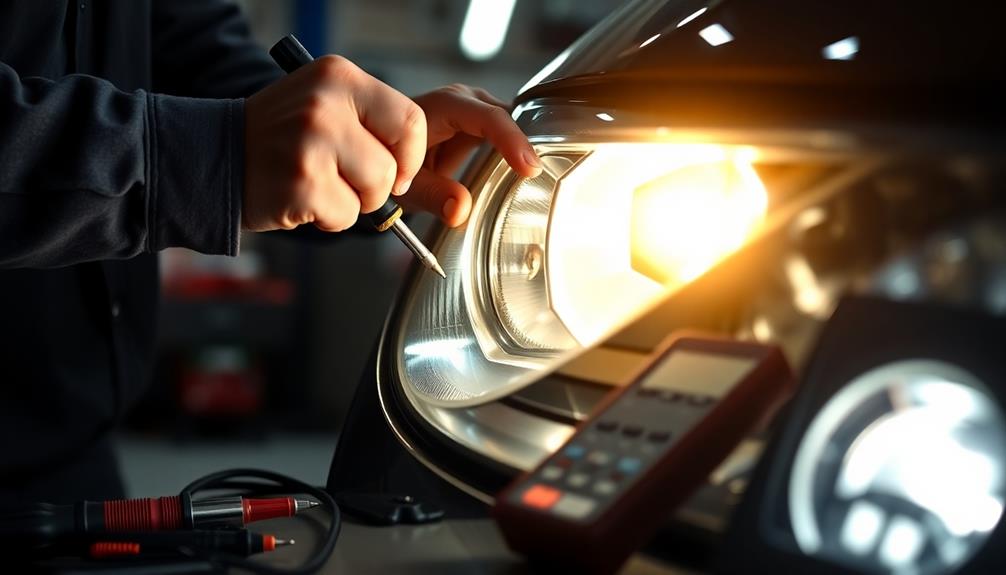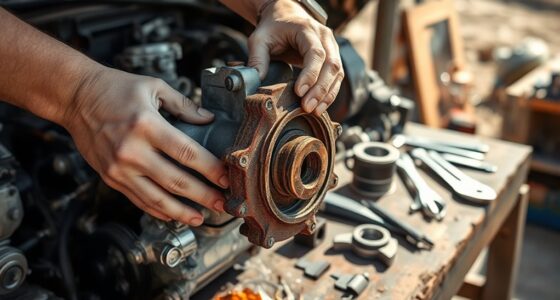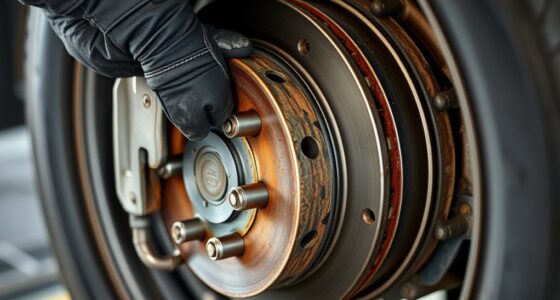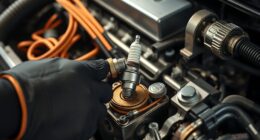If your headlights are dim, the quick fix mechanics often overlook is checking the ground connection. A faulty ground wire is responsible for 90% of dimming issues. Inspect your wiring harness for fraying or corrosion, and consider using a power probe to check voltage levels—healthy circuits should show above 9.8V. Rewiring the ground directly to the chassis can stabilize voltage flow. Regular inspections and securing connections also help maintain brightness. By understanding these common culprits, you can tackle dim headlights effectively. Stick around, and you'll uncover even more insider tips to keep your headlights shining bright!
Key Takeaways
- Check the ground wire connections, as 90% of dim headlight issues stem from faulty ground connections.
- Use a power probe to diagnose voltage levels; readings below 12V indicate problems in the circuit.
- Inspect the wiring harness for wear or fraying, which can hinder optimal headlight performance.
- Regularly clean and secure ground connections to prevent voltage drops that lead to dim headlights.
- Conduct periodic inspections of older vehicles to identify and address potential wiring problems early.
Common Causes of Dim Headlights
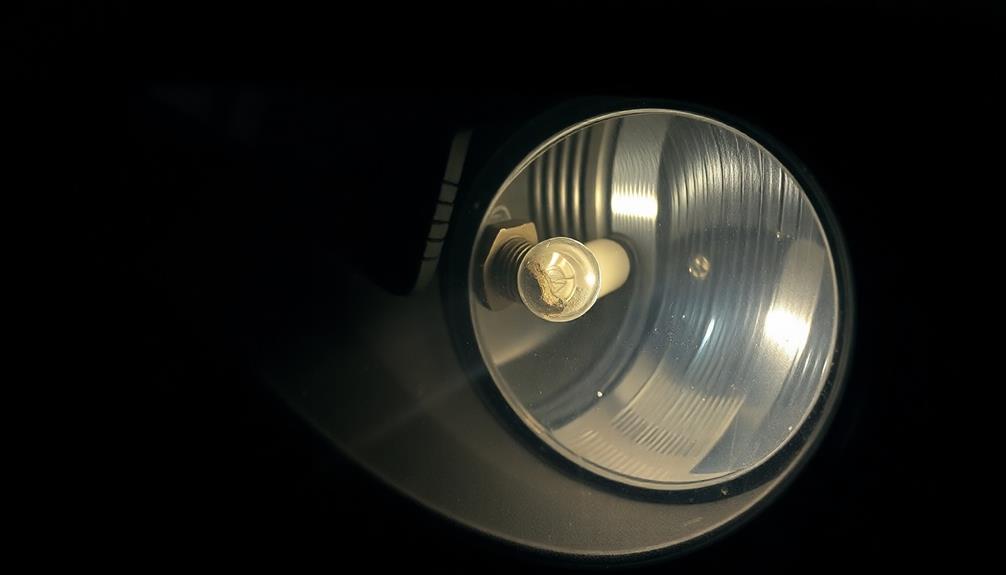
When dealing with dim headlights, understanding the common causes can save you time and frustration. One major culprit is a faulty ground wire, which accounts for 90% of dim headlight issues. If you notice that one side of your headlights is dimmer than the other, it's likely due to an inconsistent ground connection. The ground wire, typically black, is vital for proper voltage flow and light intensity.
Another common cause is a poor connection within the wiring harness. This harness connects multiple circuits, including high beam, low beam, and ground circuits. If there's wear and tear, it can lead to poor performance.
Aging vehicles are particularly susceptible to these wiring issues, so regular visual inspections of your headlight connections are important. Look for any signs of fraying or disconnection that could impact the brightness of your headlights.
Essential Diagnostic Tools
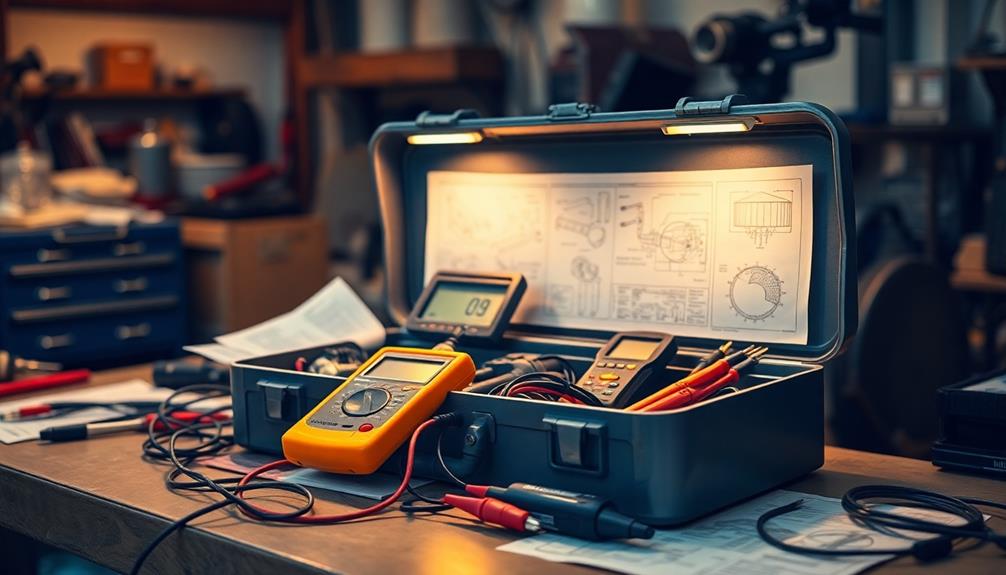
Identifying the right tools can make diagnosing dim headlights much easier. With the correct equipment, you can pinpoint issues quickly and effectively. Here are some essential tools you should have on hand:
- Power Probe: This tool is preferred over a multimeter for testing headlight circuits, as it provides real-time voltage readings that better indicate the circuit's health.
- Wiggle Method: A practical technique to spot intermittent connections. By physically moving the wiring harness while monitoring the headlights, you can identify trouble spots.
- Direct Ground Signal Tester: This helps you check the integrity of the ground wire in the headlight harness, vital for diagnosing ground issues.
- Voltage Tester: Use this to measure voltage levels; readings below 12V, like 9.8V or 3.7V, can signal underlying problems within the wiring or connections.
Understanding the Repair Process

Repairing dim headlights is often straightforward, especially when you tackle the common culprits. The majority of dim headlight issues are due to a faulty ground connection, accounting for about 90% of cases.
Start by diagnosing the ground problems using a power probe for voltage readings. Healthy circuits usually show voltages above 9.8V. If your readings are below this, you've likely found the source of the issue.
Next, you'll need to identify and rewire the faulty ground wire in the headlight harness to your vehicle's chassis. This step is essential, as a solid connection will guarantee proper voltage flow, restoring your headlights' brightness.
After you've made the necessary repairs, check the voltage readings again to confirm they're back to expected levels.
Don't forget to conduct a visual inspection of the entire headlight wiring and connections. Look for any signs of wear and tear that could affect performance.
Techniques for Wiring and Grounding
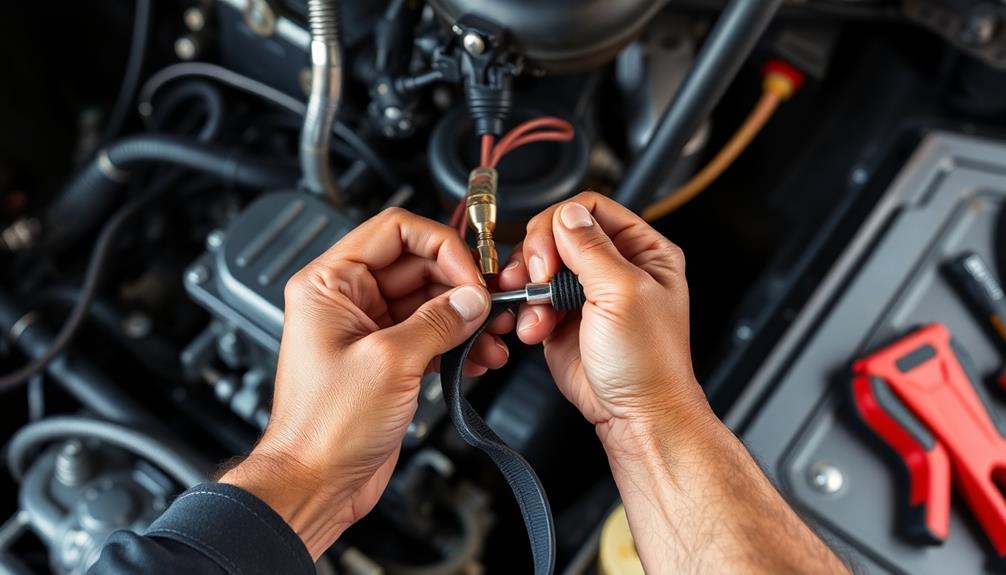
Proper wiring and grounding techniques are essential for ensuring your headlights perform at their best. When you focus on these aspects, you'll notice a significant improvement in lighting performance.
Here are some key techniques to take into account:
- Use a master ground: This central connection point stabilizes voltage distribution across your vehicle's electrical systems.
- Opt for nylon braided wire loom: This choice enhances durability and protects your wiring from wear and tear, keeping connections safe.
- Keep ground wires black: Standardizing your ground wire color makes it easier to identify and maintain them, ensuring the integrity of your connections.
- Inspect regularly: Regularly checking and maintaining your ground connections can prevent issues, especially in older vehicles prone to corrosion.
Importance of Ground Connections
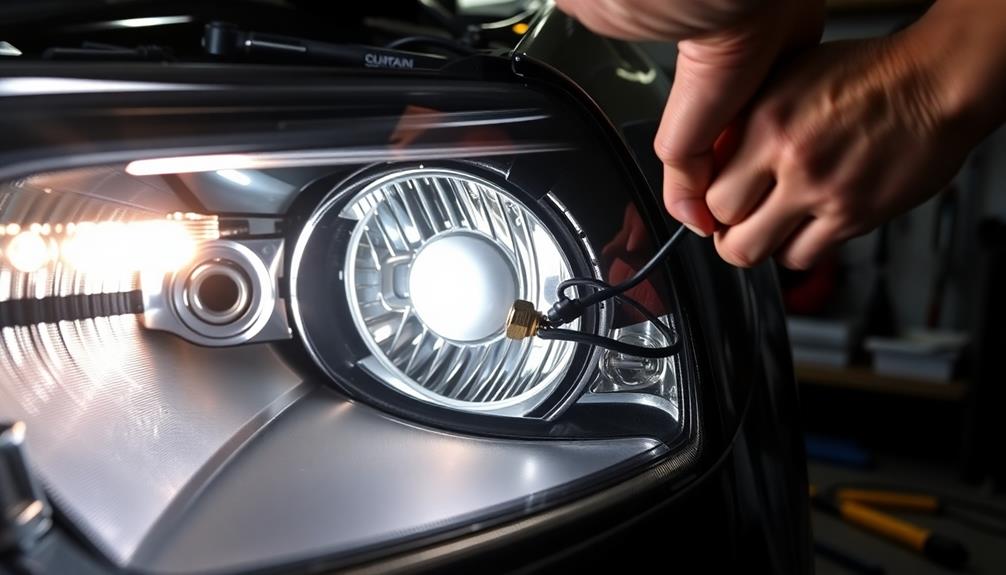
When it comes to your headlights, the integrity of the ground wire is essential for ideal brightness.
A solid master ground connection guarantees your headlights get the voltage they need to shine effectively.
If you notice dimming, it's time to check those ground connections before assuming it's a bulb issue.
Ground Wire Integrity
A reliable ground connection is essential for your headlights to shine brightly and consistently. In fact, a bad ground accounts for 90% of dim headlight issues.
When the ground connection is faulty, you can experience significant voltage drops, leading to low readings like 9.8V or even 3.7V. This indicates poor circuit health and can cause inconsistencies in brightness between your high and low beams.
To guarantee your headlights perform at their best, consider these key points:
- Regularly inspect ground connections for wear and tear.
- Rewire the ground connection directly to the chassis for stability.
- Check for any interruptions in the circuit that might affect brightness.
- Understand that proper grounding enhances overall lighting efficiency.
Master Ground Functionality
Ground connections play a vital role in your vehicle's electrical system, acting as the backbone that supports all components, including your headlights. The master ground serves as the central connection point, ensuring every part receives a stable ground reference for ideal performance.
If this connection is compromised, you might face dim headlights, a common issue that stems from poor ground connections, accounting for about 90% of such problems. A faulty ground wire can cause significant voltage drops, with readings plummeting as low as 3.7V. This reduction directly impacts the brightness and overall performance of your headlights.
Regularly inspecting and maintaining your vehicle's ground connections, especially in older models, can help prevent intermittent issues and boost the reliability of your electrical system.
To enhance the effectiveness of these connections, consider using durable materials, like nylon braided wire looms. They outperform less effective alternatives, ensuring your ground connections last longer and function better.
Maintenance Tips for Older Vehicles
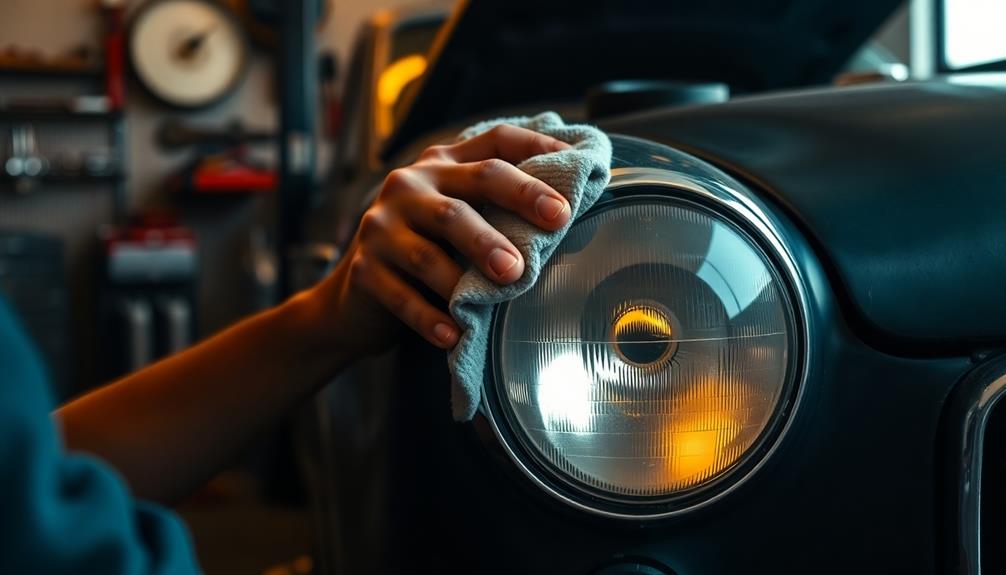
Maintaining older vehicles requires a proactive approach to guarantee safe and reliable operation. If you're driving a classic or an older model, focusing on the electrical system can help prevent issues like dim headlights.
Regular maintenance of the electrical components is as essential as understanding the principles behind systems like the refrigeration cycle that promote efficiency and performance. Here are some key maintenance tips to keep your vehicle running smoothly:
- Regularly inspect wiring harnesses for wear, corrosion, or fraying.
- Maintain clean and secure ground connections at the master ground point.
- Use a power probe to check for voltage levels near 12V in the headlight circuit.
- Schedule periodic checks of the electrical system, focusing on ground wires and connections.
Taking these steps can save you from headaches down the road. Remember to replace any worn or damaged wiring using nylon braided wire loom for added durability.
It's also vital to keep those ground connections free from rust, dirt, and loose fittings. By staying ahead of potential problems, you can enjoy a safer driving experience and enhance the longevity of your older vehicle.
Don't underestimate the importance of these simple maintenance tasks; they'll keep your headlights shining bright and your vehicle in top shape!
Enhancing Electrical System Performance

To enhance your vehicle's electrical system performance, start with a solid grounding connection, as poor grounds often lead to dim headlights.
Regularly check the integrity of your wiring harness and address any wear and tear to keep everything running smoothly.
Importance of Good Grounding
A solid grounding connection is essential for ensuring your vehicle's electrical system operates efficiently, especially when it comes to headlight brightness. Did you know that a faulty ground wire accounts for 90% of dim headlight issues? This highlights how crucial proper grounding is in your vehicle's lighting system.
With a good ground connection, you'll notice consistent brightness in your headlights, which is necessary for peak performance.
Here's why good grounding matters:
- Enhanced Brightness: Strong grounds keep your headlights shining brightly.
- Voltage Stability: A reliable ground prevents significant voltage drops, avoiding readings as low as 3.7V.
- Central Connection: Using a master ground boosts the reliability and efficiency of your electrical system.
- Durable Materials: Employing materials like nylon braided wire loom helps prevent future electrical issues.
Don't underestimate the importance of the integrity of your ground wire.
Any wear or damage can seriously compromise your vehicle's electrical performance. By ensuring solid grounding, you can enhance not only your headlights but also the overall functionality of your vehicle's electrical system.
Make grounding a priority for a safer driving experience!
Wiring Harness Integrity
How well do you understand the importance of your vehicle's wiring harness? This vital component connects various circuits, including high beams, low beams, and ground connections, directly affecting your headlights' brightness and functionality.
| Issue | Impact on Headlights |
|---|---|
| Bad ground connection | 90% of dim headlight problems |
| Wear and tear | Intermittent connections |
| Poor protection | Reduced durability |
Regularly inspecting your wiring harness is essential. Look for signs of wear and tear—this can lead to intermittent connections that can be frustrating. A simple "wiggle method" can help test these connections for reliability.
Additionally, consider using a master ground as a central connection point. This guarantees that all components receive a stable power supply, enhancing your electrical system's performance.
When it comes to protecting your wiring harness, choose nylon braided wire loom over corrugated plastic. It offers greater durability and longevity against environmental factors, which is vital for maintaining peak headlight performance. Remember, a well-maintained wiring harness can greatly reduce issues and keep your headlights shining bright.
Regular Maintenance Practices
Your vehicle's electrical system thrives on regular maintenance practices that guarantee peak performance and longevity. By committing to these practices, you can prevent dim headlights and guarantee ideal functionality.
Here are some key strategies to enhance your electrical system's performance:
- Inspect and clean ground connections regularly, as bad ground issues account for 90% of dim headlight problems.
- Use nylon braided wire loom to protect wiring, enhancing durability and preventing wear over time.
- Conduct voltage checks in the headlight circuit; this helps identify voltage drops that could affect brightness.
- Implement the wiggle method during inspections to detect intermittent connections, which can lead to inconsistent lighting performance.
Additionally, for older vehicles, schedule routine maintenance checks. This proactive approach allows you to address potential wiring issues before they escalate, guaranteeing your electrical system remains reliable.
When you make these maintenance practices a priority, you'll not only enhance your vehicle's lighting but also increase its overall electrical efficiency.
Seeking Further Assistance and Feedback
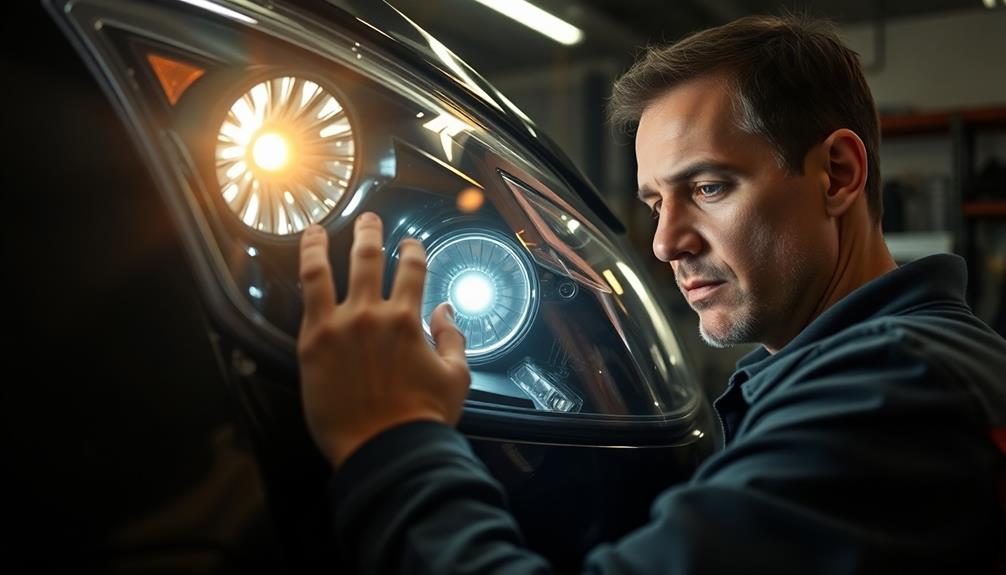
While dealing with dim headlights can be frustrating, seeking further assistance and feedback from knowledgeable sources can provide valuable insights. If you have specific questions about your headlights, don't hesitate to reach out for personalized troubleshooting. Engaging with mechanics or automotive forums can help you uncover common solutions that mightn't be widely known.
Regular maintenance on older vehicles is essential to prevent issues like wiring degradation, which can lead to dimming headlights. So, consider discussing your vehicle's upkeep with professionals who can offer tailored advice.
Additionally, subscribing to reliable automotive channels can keep you updated on maintenance tips and fixes for common vehicle issues, ensuring you stay informed.
Don't forget to provide feedback on repair videos you watch. Your input can help creators improve their content, making it more useful for others facing similar problems.
Frequently Asked Questions
How Do You Fix a Dimmed Headlight?
To fix dimmed headlights, check the ground wire for faults. Use a power probe for accurate voltage readings, and try the wiggle method to identify loose connections. Rewire the ground to restore brightness effectively.
Why Do My Headlights Seem so Dim?
You're driving down a dark road, but your headlights barely illuminate the path. Dim headlights often stem from a bad ground connection or wiring issues. Regular checks can help you avoid this frustrating situation.
Can You Drive With a Dim Headlight?
You shouldn't drive with a dim headlight. It reduces your visibility and makes it harder for others to see you, increasing the risk of accidents. Fixing it promptly guarantees safety and compliance with traffic regulations.
Why Does My Headlight Work on Bright but Not Dim?
If your headlight works on bright but not dim, it's likely due to a faulty ground connection or an issue in the low beam circuit. Check for loose wires or poor connections to resolve the problem.
Conclusion
Now that you know the common causes and fixes for dim headlights, don't let poor visibility dim your drive. With the right tools and a bit of know-how, you can light up the road ahead. Remember, maintaining good ground connections is like laying a solid foundation for your electrical system. So, keep your headlights shining bright, and don't hesitate to seek help if needed. Your safety's worth the effort—after all, a clear path is a happy journey!
